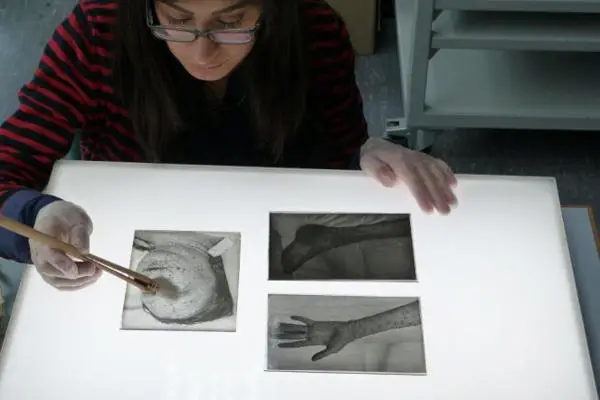Conservation: mapping and imaging smallpox in London, 1870-1910
Background
Smallpox and the Metropolitan Asylums Board
In the first half of the nineteenth century there was hardly any provision for the isolation of those suffering from infectious diseases. Guardians of the poor and sanitary authorities were supposed to provide for infectious cases, but in reality little was done. In London, the Smallpox Hospital did not help the majority as it was for paying patients.
In 1867 the Metropolitan Asylum District was formed in London for the 'relief of poor persons infected with or suffering from fever or the disease of smallpox'. The Metropolitan Asylums Board (MAB) began systematic planning by collating death statistics and calculating demand. It was decided that no patient should be moved more than three miles, and three hospitals were planned accommodating both smallpox and fever patients.
Epidemics of smallpox in 1870 and 1876 swamped facilities. The MAB was forced to rush building work on hospitals, construct temporary accommodation on spare land, use hospital ships and purchase new sites. Whenever the MAB purchased a site they were met with great local opposition due to fears of the spread of the disease into the locality. In 1882 a Royal Commission to study the subject of infectious diseases was convened. The enquiry found that there was an increased risk to a neighbourhood if a smallpox hospital was situated nearby, and recommended that hospitals be removed from urban areas and that smallpox should be treated in isolated rural hospitals or in hospital ships. In 1884 the MAB moved the hospital ships Atlas, Castalia and Endymion to Long Reach, near Dartford. A system of specialist wharves and ambulance steamers was built to transport patients from their homes to the hospital ships and from 1886 no smallpox patients were sent to the urban hospitals. The ships were not ideal though, and in 1903 the Joyce Green Hospital was opened on land opposite the ships’ moorings.
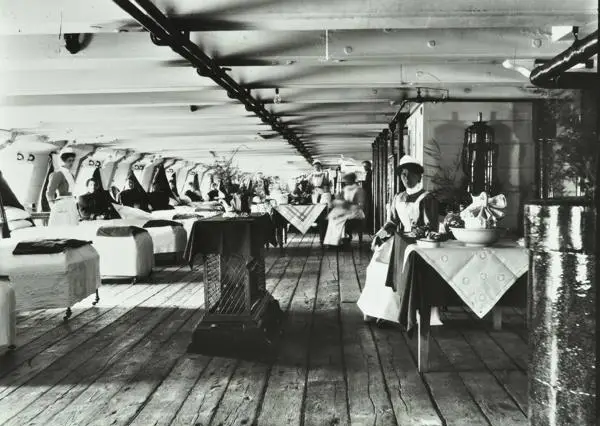
The MAB smallpox maps
Four very large smallpox maps (GLC/DG/AE/ROL/92/001-004) were created for the Royal Commission on Smallpox and Fever Hospitals by the MAB to show from what parts of London the cases of smallpox came in the epidemics of 1871-2, 1876, 1880 and in the inter-epidemic period 1873-75. The smallpox hospitals’ admission books were used as the source of the information. A fifth, smaller map (GLC/DG/AE/ROL/92/005) was created in 1885 after the Commission had finished. The maps also show radius markings to indicate the distance of cases from the hospitals. The maps, produced at the request of the Commissioners and to their instructions, were most likely displayed hanging from the wall during the hearings to support the expert evidence.
Conservation of the smallpox maps
Description
The first four maps present similar dimensions, material and structure. The maps each measure 5 x 3.2 metres; they are constructed of 6 x 6 paper panels (each 925 x 620 mm). The panels are made of two types of machine-made paper. Printing inks and water based colours have been used to draw the map. The maps were heavily lined on the back with thick linen and starch paste and attached to round and square wooden poles.
The fifth map is smaller and measures 2.74m x 4.2m; the actual image size is 1.97m x 2.71m. This map is also constructed of several panels, but they have different dimensions as well as being made of different types of machine-made paper. The map was lined on the back with a thin lining cloth applied with gelatine.
The poles to which the map was attached are rounded and of metal.
Condition before conservation
The main damage found on the maps was caused by heavy handling and the poor quality material from which the maps were made. Surface and ingrained dirt was found on both sides of the maps, especially on the panels around the poles. In those areas extensive mechanical damage was present on the paper, such as tears and losses, rigidity and planar distortions. Some of the poles were broken and the nails that were used to pin the map onto the pole had deteriorated, with the rust discolouring the paper panels.
Aim of the project
The maps were stored in LMA strong rooms and owing to their dimensions were not accessible to staff and readers, their length making it impossible to move them around the building. It was thought that digitising the maps would be the most appropriate solution in order to allow accessibility without changing their unique format. For this purpose, minimal conservation treatment was planned to stabilise the condition of the maps, allow safe handling during digitisation and produce a good quality image. After conservation and digitisation the maps would then be repackaged and taken back to the strong rooms.
Conservation treatment
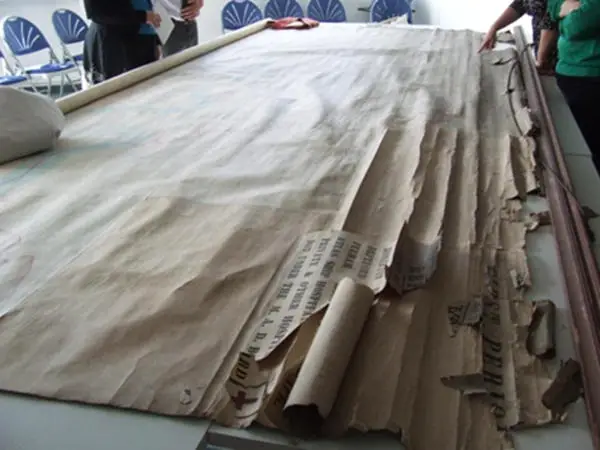
The first decision to take was how to move the maps from the strong rooms to the Conservation Studio. The maps were separated from their poles as these also contributed to the degradation of paper panels; the poles were stored separately after the project was completed. It was decided to remove the first set of panels from the rest of the map to reduce the size of the map. This decision was supported by the fact that these panels were so deteriorated that they would have required temporary removal to undergo extensive treatment in any case. Some of the inks were extremely water soluble so, before separating the panels from the map, the inks were temporarily fixed with melted cyclododecane. The maps were then rolled up around their shorter axis and moved to the Conservation Studio.
Both sides of the map were carefully dry cleaned using a chemical sponge and a soft brush. During this operation some thin pencil lines were found, so the cleaning process was slowed down to avoid deleting this important information. Once the map was cleaned the backing linen of the panels originally attached to the poles was also replaced by new unbleached aerocotton and wheat starch paste. Tears and losses on the panels were repaired using Japanese paper and tissue and wheat starch paste. Some panels that were very deteriorated, but blank, were removed and replaced with new Japanese paper panels. Flattening the panels without causing tensions along the joints proved to be quite challenging and this procedure had to be done in stages. The set of panels that was detached from the map was reattached to it only after the map was digitised; this allowed the map to be moved to the Digitisation Studio. The fifth map followed the same procedure as the other four, but due to the poor quality of its constituent material, the paper repairs proved to be more complicated and therefore it took longer to complete the work.
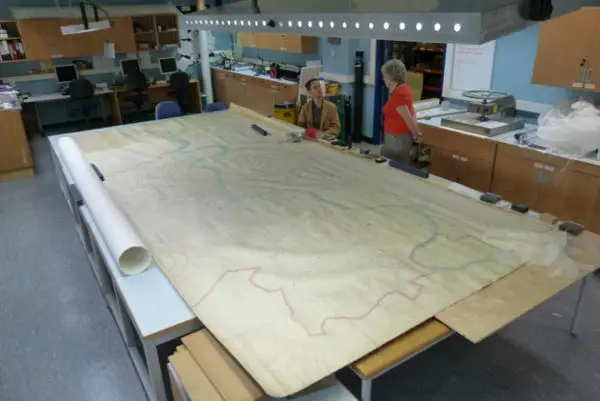
Digitisation
The digitisation of the maps gave the LMA Digital Services team an interesting challenge. Due to the maps’ large size, it was not possible to digitise each of them in one shot, so decisions had to be made about an appropriate shooting technique and the right equipment. The studio was set up to facilitate the shooting process and reduce the risk of damaging each map during handling. It was decided to photograph each panel in one shot and then stitch all the panels together virtually.
The studio floor was covered in polythene sheets so that the map was lying on a clean surface. Photographic scaffolding was purchased to accommodate the digital camera. Shooting trials were performed to establish which camera was more suitable for the job. The first attempt was made using a Canon 5d mark 2. However, as the map had some very small text on it, some less than a millimetre in height, the Canon was unable to provide this detail in a consistently readable way because it did not have high enough resolution even if the shots were taken closer to the map and two pictures were taken per panel. The more successful alternative was using a 65 megapixel Phase One digital back on a Phase One camera body. This provided just enough detail to be able to make out all the text on the map whilst returning to the approach of one shot per panel.
The large size of the images when stitched together provides a challenge for online viewing. The maps are currently only available to view digitally on site at LMA. However, as reported in the LMA newsletter earlier this year, we have published a new interface and viewing process for maps on the London Picture Archive site, providing a greatly enhanced experience for multi-sheet maps, and the smallpox maps will soon be available to view via that platform.
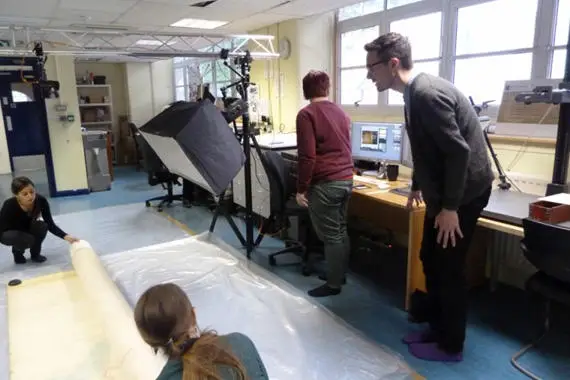
Housing
The maps were individually rolled up on bespoke archival rolls about 250 mm in diameter. To protect the maps from dust and possible unforeseen fluctuations in environmental conditions, bespoke map bags were designed to accommodate each map. The bags are made using archival material, padded with a layer of plastozote and designed to limit the handling of the maps during their extraction from the bags.
The size of the rolled up map increased in its diameter so the maps were relocated into a different strong room which still presented acceptable environmental conditions.
Conclusion
The project was successful. There were tough challenges along the way caused mainly by the unusual size of the items, which amplified the problems that are usually found on more “traditional” sized maps. The work on the maps gave an opportunity to conservators to find very creative solutions to overcome those problems, balancing between the ethics involved in conservation practices and logistic problems.
The photographic images of smallpox patients from the Joyce Green Hospital archive made for T F Ricketts
Thomas Frank Ricketts (1864-1918) was a well-known pathologist who was promoted to the position of Medical Superintendent of the Smallpox Hospitals of the Metropolitan Asylums Board at the young age of 28. According to his obituary in The Times (29 January 1918) he was 'regarded as the principal authority on smallpox', and his tenure coincided with the last major smallpox epidemics of 1893, 1894 and 1901-02, which his efforts prevented from being much worse.
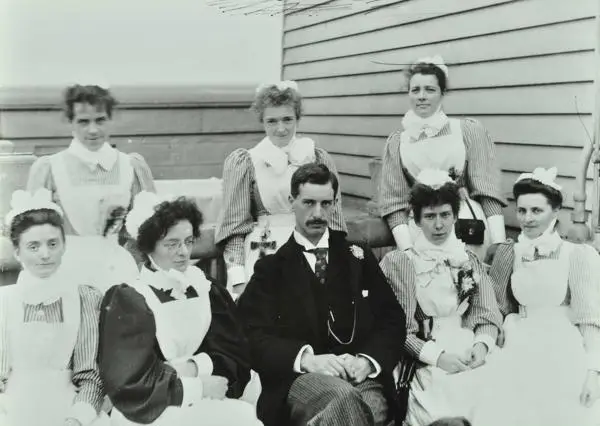
The majority of the glass plate negatives and stereoscope photographs of smallpox patients in the Joyce Green collection (H48/PH/02, 03, 04) were made as illustrations for the 1908 book The Diagnosis of Smallpox by Ricketts (H48/Y/01/003) which became the standard work on the subject. The images of smallpox patients from the negatives and photographs show various stages in the progression of the disease and the different types of the disease; or of patients presenting with diseases which also cause skin lesions that might be mistaken for smallpox. There are also images of the hospital ships and group shots of the staff.
Description
Most of the photographs (H48/PH/02/*, H48/PH/03/*) were taken around the early 1920’s using a dry process technique to produce the image. The glass plate negatives vary greatly in dimensions, from 82 x 82mm to 170 x 83mm and some are stereo photographs.
Condition
All the glass plate negatives were in good condition, but their original (wooden) box had caused some damage on the edges of the glass, like cracks and losses, probably during the extraction of the plates from the box. The surface of the plates presented dirt and dust.
Aim of the project
The aim of the project was to digitise the collection in order to reduce the potential damage caused during the handling of the plates. To produce a high quality digital image without noise caused by the surface dust, all the glass plate negatives had to be cleaned. As the original box had created a lot of damage it was decided to design new bespoke boxes.
Treatment and housing
The glass plate negatives were dusted on both sides by means of a soft brush. The plates were then individually rehoused in a four flap folder made of a paper specifically produced to enclose photographic material. The new boxes were developed in-house using the Kasemake machine to cut out the box design. The boxes are made of archival material and the internal walls padded with plastozote to reduce damage during transport and handling.
